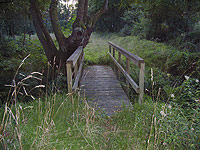Net of Natural
Trails

River Catoira eco-routes Nature Trail
Description
Old water mills and riparian forests
This Nature Trail offers two alternative routes through Pontevedra County, where water is central to the landscape since time immemorial. The water mills that dot the riverbanks, sometimes hidden amidst lush greenery, attest to this.
1 - San Cibrán River Route:

The route begins at Abalo Recreational Area, next to the Shrine of San Cibrán, the only place on this route where one can stock up on drinking water. The route begins on a path virtually overgrown with vegetation that runs down the right bank of the River Catoira. Further on, it crosses to the opposite side of a track and continues parallel to the river. There are many old mills in this area, although most are derelict.
The route advances between the river and a eucalyptus grove, along a road infrequently travelled by hikers, which in certain places goes unnoticed owing to abundant overgrowth. This path leads to a small wooden bridge. Further on, the path arrives at a meadow with an old mill to the right.
The Trail traverses next through a vineyard and open meadows, crosses a small paved road, and continues amidst riparian vegetation, accompanied at all times by chirping birds. In its final stretch, the route crosses over several small stone bridges to reach Barral Recreational Area, where the route reaches the River Catoira, running along its banks.
2 - River Catoira Route:

The second route along this Nature Trail begins at Porto Canlés Recreational Area, from where it climbs down to the left bank of the river through a well-preserved riparian forest ecosystem with dense shrubbery. A few meters after the start, it crosses a small stone bridge next to an old mill, and continues downstream along the right bank of Catoira.
The Trail reaches a paved road that crosses the river again, and continues along the left bank to a stone bridge, which it does not cross, as the route heads downstream along a vineyard. Past a dense scrubland, the Trail reaches and crosses a major road (PO-548), and continues along the right bank of the river.
The route ventures into a riparian forest, passing close to a few old mills, virtually concealed by the dense vegetation, and then crosses a narrow paved road to continue straight ahead. Past a small wooden bridge over a creek the empties into the River Catoira, the route passes near several stone bridges and mills, until it reaches a washhouse on the riverbank, opposite Barral Recreational Area.

From here, the Trail continues downstream to a narrow stone bridge on the river. It crosses the bridge and continues along the right bank to the main road leading to the town of Catoira. The route crosses this road and continues under an arbour between houses until it reaches the river. After crossing the river again, the route continues along the left bank, passing next a mill. One last wooden bridge leads to a fountain adjacent to a flight of stairs leading to the town of Catoira, and the end of this route.
Sites of interest
Profile

Highlights
Further information
Shrine of San Cibrán
The Shrine of San Cibrán is located on the north slope of Mount Xiabre (647 m), in the municipal district of Abalo, Catoira.
The Baroque building, built entirely with carved stone, has undergone several alterations and additions. Although the year engraved under a window appears to be 1671, the exact date of its foundation is unknown.
Further to the east of the shrine is a 4.5-metre cross on flagstones, which is believed to be from the eighteenth century. The cross has a crucified Christ facing the shrine, and a Pieta on the opposite side.
The Viking invasion of Catoira
PCatoira is home to possibly the most famous festival in this area, which takes place on the first Sunday of August. It consists of staged battles against the Vikings that ravaged these lands more than a millennia ago, when they tried to reach Compostela, sailing up the River Ulla.
This tradition, which dates back to 1960, has been declared a Festival of International Tourist Interest. Thousands of people come to this town, where locals dress up as Viking warriors to re-enact the pirate attack of Catoira, sailing on board faithful replicas of Drakkars, the spectacular ships used by these Northern invaders. Their goal is to conquer the remains of the West Tower (a medieval defensive structure near the town)
Dressed in costumes with period weapons, the locals wage a battle against the invaders, where the only red liquid spilled is wine.
After the battle, locals, Vikings and tourists participate in a fellowship picnic, marked with the sound of typical Galician bagpipes.
Torres del Oeste and Chapel of Santiago
Located where the River Ulla meets the Ría de Arousa estuary, this is an archaeological site consisting of a set of towers of Roman origin that served as a fundamental element of the defence of the lands of the Archdiocese of Santiago de Compostela from Norman attack during the Early and Late Middle ages. Due to the weak existing defences in the area, King Alfonso V decided to donate the Island of Oneste to the church, for the construction of a fortress in the year 1024. Years later the defences were reinforced with more solid walls and a chapel was added in honour of St. James the Apostle (Santiago).










